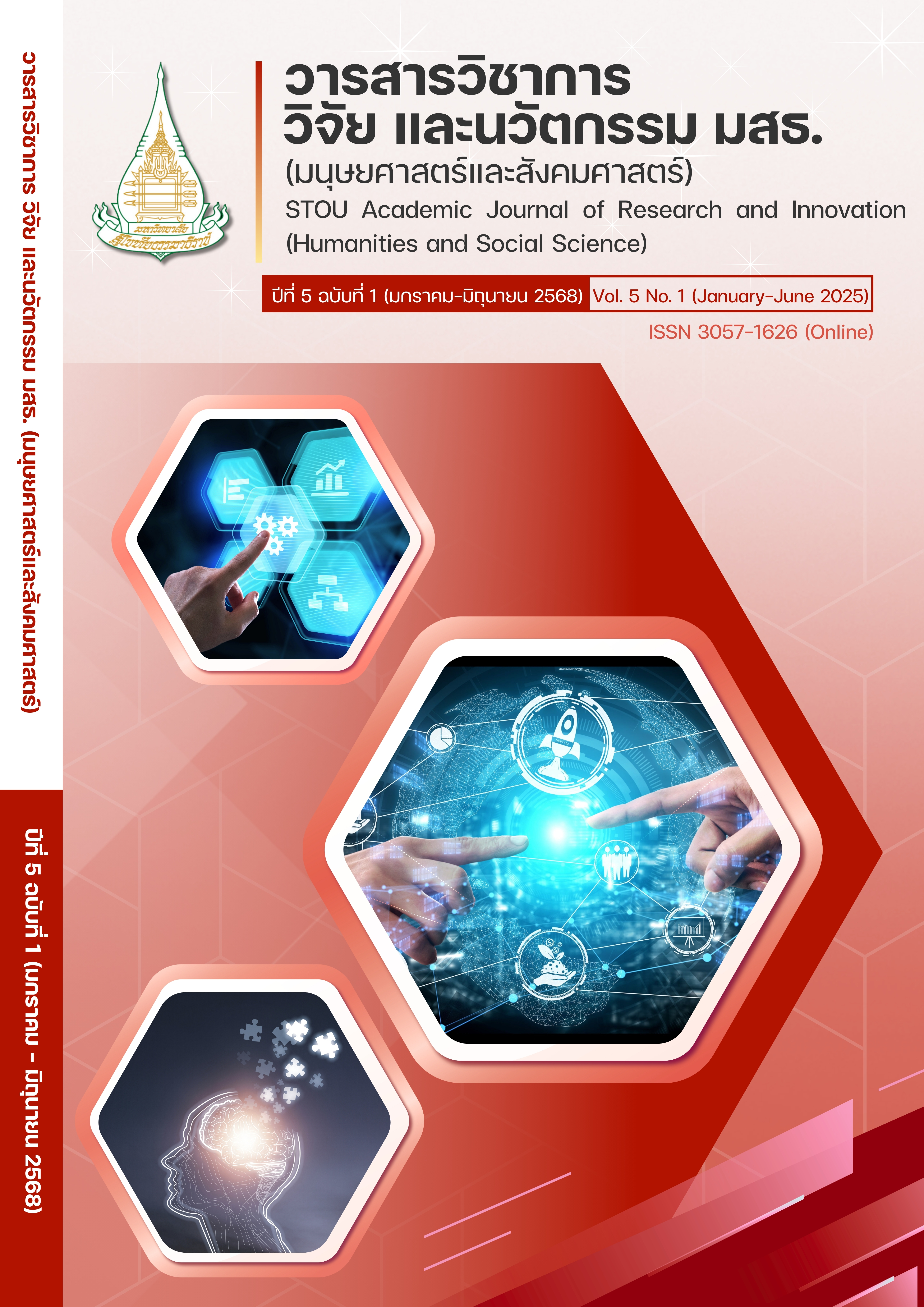The Communication of Online Sports and Health Influencers and Exercise and Healthcare Behaviors of Working-age Population
Keywords:
Influencer, Online Media, Exercise Behavior, HealthcareAbstract
This research aims to study: 1) the influence of information exposure to online sports and health influencers on the attitudes of the working-age population; 2) the impact of information exposure to online sports and health influencers on exercise and healthcare behaviors of the working-age population; 3) the correlation between attitudes toward online sports and health influencers, and exercise and healthcare behaviors of the working-age population; and 4) the correlation between information exposure and attitudes toward online sports and health influencers, and the exercise and healthcare behaviors of the working-age population. The research is conducted by a survey using questionnaire as a tool for collecting data from a sample of 400 individuals who are familiar with and have ever exposed to information from online sports and health influencers.
The research findings indicate that 1) different levels of information exposure to online sports and health influencers affect the attitudes of the working-age population differently; 2) different levels of information exposure to online sports and health influencers have an impact on the exercise and healthcare behaviors of the working-age population differently; 3) attitudes toward online sports and health influencers are positive and correlate with the exercise and healthcare behaviors of the working-age population; and 4) the information exposure to online sports and health influencers and attitudes toward such influencers have a statistically significant positive correlation with the exercise and healthcare behaviors of the working-age population, with a multiple regression coefficient (R2) of 0.769 for prediction.
References
กิติยา สุริวรรณ, พิชามน พวงสุวรรณ, และอุรพี จุลิมาศาสตร์. (2559). ความสัมพันธ์ระหว่างผู้ทรงอิทธิพลทางความคิด ผู้บริโภค และตราสินค้า. วารสารการสื่อสารและการจัดการนิด้า, 2, 79-96.
ชนิดา กิ่งรุ้งเพชร์. (2561). ผู้ทรงอิทธิพลทางความคิดในอินสตาแกรมสำหรับสินค้าประเภทอาหารและเครื่องดื่มกับการเปิดรับ ทัศนคติและพฤติกรรมการตอบสนองของผู้บริโภค [วิทยานิพนธ์ปริญญามหาบัณฑิต, จุฬาลงกรณ์มหาวิทยาลัย].
ณัฐพัชญ์ วงษ์เหรียญทอง. (2556). ถอดรหัส “อิทธิพล” ของ INFLUENCER ในมิติที่มากกว่าแค่ FAN/ FOLLOWER. https://www.nuttapuch.com/decoding-influence-social-capital/
เดลินิวส์ออนไลน์. (2022). เจาะลึกพฤติกรรมคนไทย? ในวันที่ขาดอินเทอร์เน็ตไม่ได้!!. https://www.dailynews.co.th/news/1406853/
ปนัดดา เซ็นเชาวนิช. (2556). การสื่อสารของผู้มีอิทธิพลด้านความงามทางสื่อออนไลน์ และการเปิดรับข้อมูล ทัศนคติ และการตัดสินใจซื้อผลิตภัณฑ์เครื่องสำอางของผู้บริโภค [วิทยานิพนธ์ปริญญามหาบัณฑิต, จุฬาลงกรณ์มหาวิทยาลัย].
ภัสสร ปราชญากูล. (2554). กลยุทธ์การกำหนดเอกลักษณ์และการสื่อสารตราสินค้าบุคคลของผู้มีอิทธิพลออนไลน์ไทยผ่านเฟซบุ๊กแฟนเพจ [วิทยานิพนธ์ปริญญามหาบัณฑิต, จุฬาลงกรณ์มหาวิทยาลัย].
รัฐญา มหาสมุทร, วรัชญ์ ครุจิต. (2559). กลยุทธ์การสื่อสารของผู้ทรงอิทธิพลทางความคิดในโลกออนไลน์ที่มีผลต่อทัศนคติของกลุ่มผู้ติดตาม. วารสารนิเทศศาสตร์และนวัตกรรม นิด้า, 2(1), 81-106.
ลัดดาวัลย์ เพชรโรจน์ และอัจฉรา ชำนิประศาสน์. (2547). ระเบียบวิธีการวิจัย. พิมพ์ดีการพิมพ์.
ศิริลักษณ์ สุวรรณวงศ์. (2538). ทฤษฎีและเทคนิคการสุ่มตัวอย่าง. โอเดียนสโตร์.
อารีรัตน์ สุขอมรรัตน์. (2555). ความเป็นผู้นำทางความคิดของบล็อกเกอร์ด้านความงามกับการรับรู้ ทัศนคติและการตัดสินใจซื้อผลิตภัณฑ์ด้านความงามของผู้บริโภค [วิทยานิพนธ์ปริญญามหาบัณฑิต, จุฬาลงกรณ์มหาวิทยาลัย].
อาอุน ไทย. (2565). Marketing blog: Content Marketing คืออะไร? ใช้กลยุทธ์ทำคอนเทนต์อย่างไรให้ปัง. https://seo-web.aun-thai.co.th/blog/marketing-blog-content-marketing
Assael, H. (1998). Consumer behavior and marketing action. South-Western College Publishing.
Boone, L. E., & Kurtz, D. L. (1995). Contemporary marketing plus. The Dryden Press.
Cronbach, L. J. (1990). Essentials of psychological testing (5th ed.). Harper Collins Publishers.
Digimusketeers. (2023). สื่อออนไลน์ หมายถึงอะไร มีกี่ประเภท มีข้อดี-ข้อเสียอะไรบ้าง. https://digimusketeers.co.th/blogs/สื่อออนไลน์-หมายถึงอะไร
Gibson, J. R. (2000). Organizations behavior (7ᵗʰ ed.). Irwin.
Hfocus. (2022). สสส.เผยสถานการณ์หลังโควิด กระทบการกินคนไทยขาดสมดุล อาหารไขมันท่วม. https://www.hfocus.org/content/2022/05/25135
Hoyer, W. D., & MacInnis, D. J. (1997). Consumer behavior. Houghton Mifflin.
Kemp, S. (2021). Digital 2022: Thailand. https://datareportal.com/reports/digital-2022-thailand
McCombs, M. E., & Becker, L. B. (1979). Using mass communication. Prentice Hall.
Newstorm, W. J., & Davis, K. (2002). Organization behavior. McGraw Hill.
Schermerhorn, J. R. (2000). Management (7ᵗʰ ed.). John Wiley & Sons.
Step Academy. (2021). รู้จักกับ Influencer ทั้ง 12 ประเภท เพื่อทำการตลาดให้ตอบโจทย์กับกลุ่มเป้าหมาย. https://stepstraining.co/content/12-typtes-of-influencer.
Wenner, L. A. (1985). The nature of gratifications. In Media gratifications research: Current perspective. Sage.
Downloads
Published
How to Cite
Issue
Section
License
Copyright (c) 2025 วารสารวิชาการ วิจัย และนวัตกรรม มสธ. (มนุษยศาสตร์และสังคมศาสตร์) (ออนไลน์)

This work is licensed under a Creative Commons Attribution-NonCommercial-NoDerivatives 4.0 International License.





